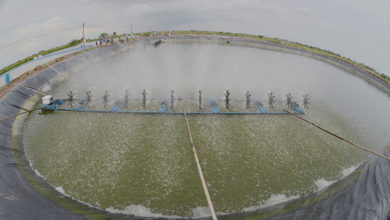Tran’s vision to transform Vietnam’s shrimp industry
Loc Tran is set to launch a new 30-hectare shrimp farm with a 1,500-tonne capacity, aiming to inspire a new generation of farmers in Vietnam.
A year ago, Tran sought investors to establish a model farm aimed at supporting the struggling shrimp industry, which was grappling with high costs, inefficiencies, and low global prices. He highlighted that traditional shrimp farming is inefficient, with small farmers facing limited access to financing and navigating complex supply chains, as reported by Thefishsite.
Over the years, challenges such as environmental issues, food safety, and high production costs have intensified. Tran reflected that shrimp farming began 30 years ago with small-scale, profitable methods, but as it grew, issues like efficiency and animal welfare arose.

Due to these challenges, Tran sought investors to help establish a modern, efficient shrimp farm that could cut costs and protect the environment. Initially, he planned a USD 15 million model farm producing 5,000 tonnes annually. However, as the price crisis persisted, he decided to act sooner. “Why not start now and see the real costs?” he said. “Instead of 100 hectares, why not 30? Instead of USD 15 million, why not start small?”
Our economic models show that the ideal farm size is between 1,000 and 2,000 metric tonnes, generating USD 5–8 million annually. At this scale, we gain bargaining power while keeping management manageable. Larger farms become overly complex, so we’ve adopted a modular approach to design, waste treatment, operations, warehousing, and management,” he explains.
Tran chose to build his farm on a failing shrimp farm, where declining returns made the owners eager to sell. “Climate change, diseases, and waste from irresponsible farming are killing extensive farming,” he explains. He aims to make his new farm as sustainable as possible.
Tran emphasizes the importance of conducting thorough environmental impact assessments for intensive farming, ensuring transparency in wastewater discharge. “Everything will be monitored in real time and broadcast live, allowing us to intensify farming without harming traditional extensive methods,” he explains.
The farm plans to plant 25-30% of its area with mangroves to absorb nitrogen and phosphorus from discharge water. Recently, it received a USD 100,000 grant from the Dutch government to analyze the full life cycle of its shrimp. Shrimp farming has a high carbon footprint, about 13 kg per kg of shrimp. The goal is to improve efficiency by 70% in the short term, cutting emissions to 30% of current levels, and eventually become carbon neutral through innovation and scale.
To minimize risks, Tran created a business plan focusing on selecting the right technologies. “I set some golden rules for the budget: expensive equipment tends to depreciate, so I aimed for a good assets-to-liabilities ratio. I spent about $1 million on land and another $1 million on infrastructure, including excavation, power grid, liners, equipment, and warehousing. Everything must be durable and last at least ten years,” he says.
This resulted in fixed costs of USD 150,000 per year over 10 years. If the farm produces 1,500 tonnes of shrimp annually, even with low prices, Tran projected a profit of USD 1 per kg of shrimp. “We only need to operate 10-15% of capacity to break even,” he notes. Economies of scale further improve efficiency. “With just 15 workers, each producing 100 tonnes per year, the farm is ten times more efficient than traditional shrimp farming,” he adds.
Tran is expanding his shrimp farming business, aiming to double the number of modules built annually. He plans to introduce a technology transfer system to pass on his model to younger shrimp farmers. By 2030, he hopes to have 50 modules across Vietnam.
His goal is to achieve similar production levels to the entire industry, but using just 1% of the available land. Tran believes his approach can help address the industry’s generational crisis, as older farmers struggle with inefficiency and debt. He is committed to proving his system’s success by allowing others to visit and learn from his farms.
Tran has received significant interest in his shrimp farming project from shrimp buyers and feed mills, noting that many feed plants are keen to modernize farming methods. While facing challenges, including the need to scale up operations and deal with typhoon delays, Tran finds the experience inspiring and educational. He aims to stock the farm by November and harvest by the Lunar New Year, hoping to draw attention to his sustainable farming concept. His goal is to revolutionize shrimp farming into a profitable, long-term industry for future generations.
VFM






